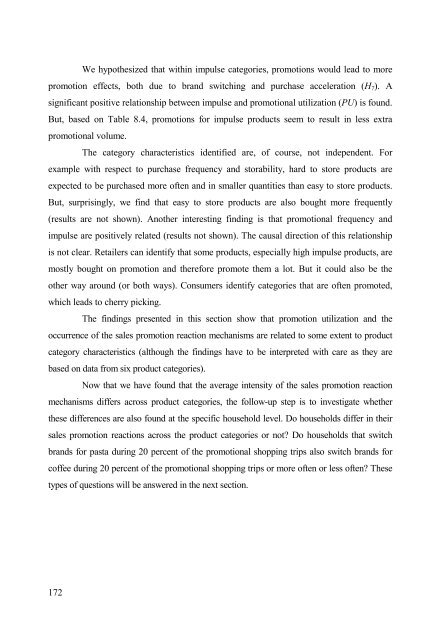Analysis of Sales Promotion Effects on Household Purchase Behavior
Analysis of Sales Promotion Effects on Household Purchase Behavior
Analysis of Sales Promotion Effects on Household Purchase Behavior
You also want an ePaper? Increase the reach of your titles
YUMPU automatically turns print PDFs into web optimized ePapers that Google loves.
We hypothesized that within impulse categories, promoti<strong>on</strong>s would lead to more<br />
promoti<strong>on</strong> effects, both due to brand switching and purchase accelerati<strong>on</strong> (H7). A<br />
significant positive relati<strong>on</strong>ship between impulse and promoti<strong>on</strong>al utilizati<strong>on</strong> (PU) is found.<br />
But, based <strong>on</strong> Table 8.4, promoti<strong>on</strong>s for impulse products seem to result in less extra<br />
promoti<strong>on</strong>al volume.<br />
The category characteristics identified are, <str<strong>on</strong>g>of</str<strong>on</strong>g> course, not independent. For<br />
example with respect to purchase frequency and storability, hard to store products are<br />
expected to be purchased more <str<strong>on</strong>g>of</str<strong>on</strong>g>ten and in smaller quantities than easy to store products.<br />
But, surprisingly, we find that easy to store products are also bought more frequently<br />
(results are not shown). Another interesting finding is that promoti<strong>on</strong>al frequency and<br />
impulse are positively related (results not shown). The causal directi<strong>on</strong> <str<strong>on</strong>g>of</str<strong>on</strong>g> this relati<strong>on</strong>ship<br />
is not clear. Retailers can identify that some products, especially high impulse products, are<br />
mostly bought <strong>on</strong> promoti<strong>on</strong> and therefore promote them a lot. But it could also be the<br />
other way around (or both ways). C<strong>on</strong>sumers identify categories that are <str<strong>on</strong>g>of</str<strong>on</strong>g>ten promoted,<br />
which leads to cherry picking.<br />
The findings presented in this secti<strong>on</strong> show that promoti<strong>on</strong> utilizati<strong>on</strong> and the<br />
occurrence <str<strong>on</strong>g>of</str<strong>on</strong>g> the sales promoti<strong>on</strong> reacti<strong>on</strong> mechanisms are related to some extent to product<br />
category characteristics (although the findings have to be interpreted with care as they are<br />
based <strong>on</strong> data from six product categories).<br />
Now that we have found that the average intensity <str<strong>on</strong>g>of</str<strong>on</strong>g> the sales promoti<strong>on</strong> reacti<strong>on</strong><br />
mechanisms differs across product categories, the follow-up step is to investigate whether<br />
these differences are also found at the specific household level. Do households differ in their<br />
sales promoti<strong>on</strong> reacti<strong>on</strong>s across the product categories or not? Do households that switch<br />
brands for pasta during 20 percent <str<strong>on</strong>g>of</str<strong>on</strong>g> the promoti<strong>on</strong>al shopping trips also switch brands for<br />
c<str<strong>on</strong>g>of</str<strong>on</strong>g>fee during 20 percent <str<strong>on</strong>g>of</str<strong>on</strong>g> the promoti<strong>on</strong>al shopping trips or more <str<strong>on</strong>g>of</str<strong>on</strong>g>ten or less <str<strong>on</strong>g>of</str<strong>on</strong>g>ten? These<br />
types <str<strong>on</strong>g>of</str<strong>on</strong>g> questi<strong>on</strong>s will be answered in the next secti<strong>on</strong>.<br />
172

















